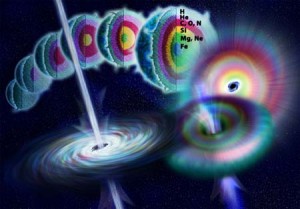Mega Gamma
What’s cool about the universe is that if you stare at nothing long enough, you’ll see something big. That’s what scientists have done with the Hubble Space Telescope a few times, creating the enchanting Hubble Deep Field images with swarms of galaxies that have opened our eyes to the immensity of …
What's cool about the universe is that if you stare at nothing long enough, you'll see something big. That's what scientists have done with the Hubble Space Telescope a few times, creating the enchanting Hubble Deep Field images with swarms of galaxies that have opened our eyes to the immensity of the cosmos.
But sometimes the universe comes to you, as it did last April 23 when a gamma ray burst now named GRB 090423 was detected by NASA's orbiting Swift satellite. Gamma ray bursts are the most violent explosions known, and occur when a star perhaps 20 times the size of our sun exhausts its fuel. Its core collapses under the force of the star's gravity and becomes a black hole while outer layers fly off. Then matter falling into that hole produces a powerful jet of gamma rays that flare outward in opposite directions. If one of those jets is pointed at us, it is so energetic that (we now know) we can detect it from a distance of 13.1 billion light years, which is how far away this burst originated. That's more than 95 percent of the distance across the known universe, and 190 million light years farther away than the previous record holder.

Astronomers estimate the explosion occurred 630 million years after the Big Bang, when the first stars were forming. Astronomers also think the first stars formed no earlier than 150 million years after the Big Bang. So GRB 090423 would have been only a few hundred million years old when it blew. That sounds like a big number until you compare it to the age of stable stars such as our sun that burn for 10 billion years before they swell into a red giant, then smolder into a white dwarf for another five billion or more.
Here's a good video on the Nature web site that explains it.
But sometimes the universe comes to you, as it did last April 23 when a gamma ray burst now named GRB 090423 was detected by NASA's orbiting Swift satellite. Gamma ray bursts are the most violent explosions known, and occur when a star perhaps 20 times the size of our sun exhausts its fuel. Its core collapses under the force of the star's gravity and becomes a black hole while outer layers fly off. Then matter falling into that hole produces a powerful jet of gamma rays that flare outward in opposite directions. If one of those jets is pointed at us, it is so energetic that (we now know) we can detect it from a distance of 13.1 billion light years, which is how far away this burst originated. That's more than 95 percent of the distance across the known universe, and 190 million light years farther away than the previous record holder.

Astronomers estimate the explosion occurred 630 million years after the Big Bang, when the first stars were forming. Astronomers also think the first stars formed no earlier than 150 million years after the Big Bang. So GRB 090423 would have been only a few hundred million years old when it blew. That sounds like a big number until you compare it to the age of stable stars such as our sun that burn for 10 billion years before they swell into a red giant, then smolder into a white dwarf for another five billion or more.
Here's a good video on the Nature web site that explains it.